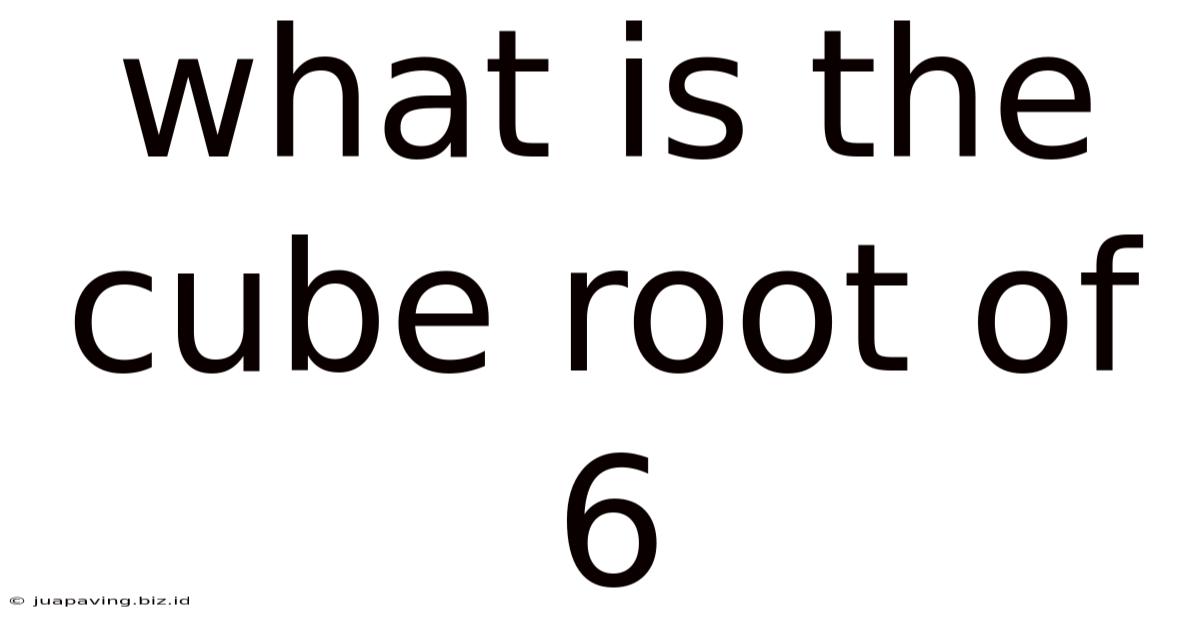What Is The Cube Root Of 6
Juapaving
May 10, 2025 · 4 min read

Table of Contents
What is the Cube Root of 6? A Deep Dive into Calculation and Applications
The question, "What is the cube root of 6?" seems deceptively simple. It's a fundamental mathematical concept, yet understanding its nuances reveals a fascinating journey into numerical analysis, approximation techniques, and even the practical applications of this seemingly abstract concept. This article will delve deep into the cube root of 6, exploring various methods of calculation, discussing its approximate value, and showcasing its relevance in diverse fields.
Understanding Cube Roots
Before we tackle the cube root of 6 specifically, let's establish a solid foundation. The cube root of a number, denoted as ³√x, is a value that, when multiplied by itself three times (cubed), equals the original number x. In other words, if y = ³√x, then y³ = x.
For example:
- ³√8 = 2 because 2 * 2 * 2 = 8
- ³√27 = 3 because 3 * 3 * 3 = 27
- ³√1 = 1 because 1 * 1 * 1 = 1
Calculating the Cube Root of 6: The Challenges
Unlike perfect cubes like 8 or 27, 6 doesn't have a whole number cube root. This means the cube root of 6 is an irrational number, meaning it cannot be expressed as a simple fraction and its decimal representation goes on forever without repeating. This presents a challenge in calculating its precise value.
Methods for Approximating the Cube Root of 6
Several methods can be employed to approximate the cube root of 6:
1. Using a Calculator
The most straightforward method is using a scientific calculator. Most calculators have a dedicated cube root function (often denoted as ³√ or x^(1/3)). Simply input 6 and apply the cube root function. The calculator will provide a decimal approximation, typically accurate to several decimal places. This is the most practical method for everyday use.
2. The Babylonian Method (Newton-Raphson Method)
This iterative method provides increasingly accurate approximations with each iteration. It's based on refining an initial guess using a formula. Let's outline the steps:
-
Make an initial guess: Let's start with a guess of 2, as 2³ = 8, which is relatively close to 6.
-
Apply the formula: The iterative formula for the Babylonian method for cube roots is:
x_(n+1) = (1/3) * [2x_n + (a / x_n²)]
Where:
- x_n is the current approximation
- x_(n+1) is the next approximation
- a is the number whose cube root we are seeking (in this case, 6)
-
Iterate: Let's perform a few iterations:
- Iteration 1: x_1 = (1/3) * [2(2) + (6 / 2²)] = 1.8333...
- Iteration 2: x_2 = (1/3) * [2(1.8333...) + (6 / (1.8333...)²)] ≈ 1.8172...
- Iteration 3: x_3 = (1/3) * [2(1.8172...) + (6 / (1.8172...)²)] ≈ 1.81712...
As you can see, the approximation converges quickly towards the actual value.
3. Binary Search Method
This method involves systematically narrowing down the range within which the cube root lies. We start with a range (e.g., 1 to 2) and repeatedly halve the range, keeping the half that contains the cube root. This process continues until the desired level of accuracy is achieved. This method is less efficient than the Babylonian method but demonstrates a different approach to approximation.
The Approximate Value of the Cube Root of 6
Using a calculator or several iterations of the Babylonian method, we find that the cube root of 6 is approximately 1.8171205928. Remember that this is an approximation; the actual value is irrational and continues infinitely.
Applications of Cube Roots
While the cube root of 6 might seem like an abstract mathematical concept, it finds applications in various fields:
-
Engineering: Cube roots are used in calculations involving volumes, especially when dealing with cubic shapes or three-dimensional structures. For example, calculating the side length of a cube given its volume involves taking the cube root.
-
Physics: Many physical phenomena involve cubic relationships, requiring the use of cube roots in calculations. For instance, certain equations in fluid dynamics or wave propagation might involve cube roots.
-
Chemistry: In chemistry, cube roots can be found in calculations related to molarity, concentration, and other concepts involving three-dimensional space.
-
Finance: While less common than square roots, cube roots can appear in certain financial models and calculations related to compound interest or growth over time.
-
Computer Graphics: In 3D graphics and modeling, cube roots can be involved in transformations, scaling, and other geometric calculations within three-dimensional space.
-
Statistics: Cube roots can be employed in statistical analysis, particularly when dealing with data transformations or certain probability distributions.
Conclusion: More Than Just a Number
The cube root of 6, despite its seemingly simple appearance, exemplifies the richness and complexity of mathematics. Its calculation necessitates an understanding of numerical approximation techniques and highlights the distinction between rational and irrational numbers. Furthermore, its applications demonstrate the relevance of this mathematical concept to various practical disciplines, showcasing the pervasive nature of mathematics in the real world. Understanding how to calculate and approximate cube roots, therefore, is a valuable skill with practical applications across multiple fields.
Latest Posts
Latest Posts
-
Let F Be A Twice Differentiable Function
May 10, 2025
-
Application Of Matrix In Daily Life
May 10, 2025
-
Who Was The First To See Cells
May 10, 2025
-
How To Find The Square Root Of 7
May 10, 2025
-
Explain The Four Principles Of Natural Selection
May 10, 2025
Related Post
Thank you for visiting our website which covers about What Is The Cube Root Of 6 . We hope the information provided has been useful to you. Feel free to contact us if you have any questions or need further assistance. See you next time and don't miss to bookmark.